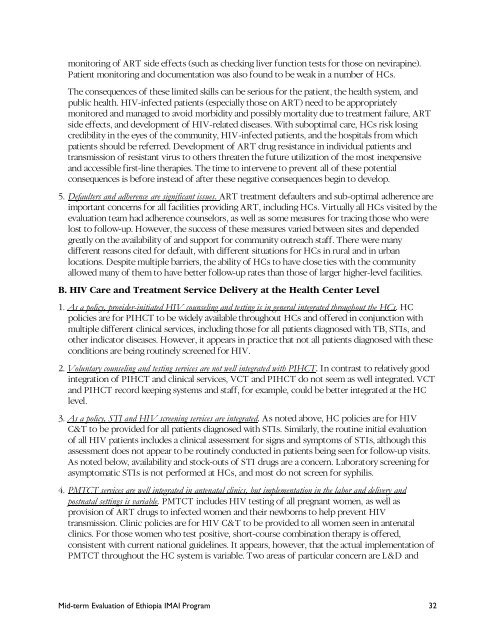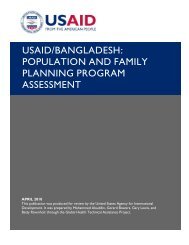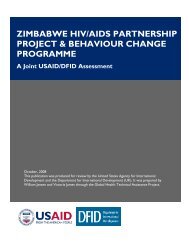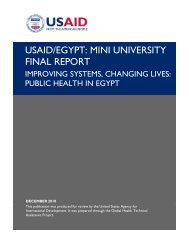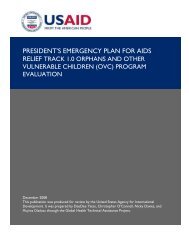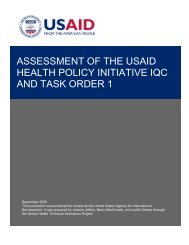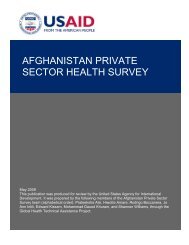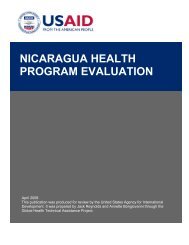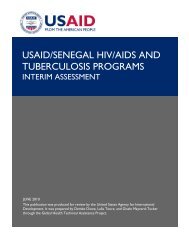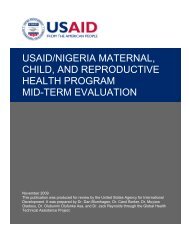usaid/ethiopia pepfar mid-term evaluation of the ... - GH Tech
usaid/ethiopia pepfar mid-term evaluation of the ... - GH Tech
usaid/ethiopia pepfar mid-term evaluation of the ... - GH Tech
- No tags were found...
Create successful ePaper yourself
Turn your PDF publications into a flip-book with our unique Google optimized e-Paper software.
monitoring <strong>of</strong> ART side effects (such as checking liver function tests for those on nevirapine).Patient monitoring and documentation was also found to be weak in a number <strong>of</strong> HCs.The consequences <strong>of</strong> <strong>the</strong>se limited skills can be serious for <strong>the</strong> patient, <strong>the</strong> health system, andpublic health. HIV-infected patients (especially those on ART) need to be appropriatelymonitored and managed to avoid morbidity and possibly mortality due to treatment failure, ARTside effects, and development <strong>of</strong> HIV-related diseases. With suboptimal care, HCs risk losingcredibility in <strong>the</strong> eyes <strong>of</strong> <strong>the</strong> community, HIV-infected patients, and <strong>the</strong> hospitals from whichpatients should be referred. Development <strong>of</strong> ART drug resistance in individual patients andtransmission <strong>of</strong> resistant virus to o<strong>the</strong>rs threaten <strong>the</strong> future utilization <strong>of</strong> <strong>the</strong> most inexpensiveand accessible first-line <strong>the</strong>rapies. The time to intervene to prevent all <strong>of</strong> <strong>the</strong>se potentialconsequences is before instead <strong>of</strong> after <strong>the</strong>se negative consequences begin to develop.5. Defaulters and adherence are significant issues. ART treatment defaulters and sub-optimal adherence areimportant concerns for all facilities providing ART, including HCs. Virtually all HCs visited by <strong>the</strong><strong>evaluation</strong> team had adherence counselors, as well as some measures for tracing those who werelost to follow-up. However, <strong>the</strong> success <strong>of</strong> <strong>the</strong>se measures varied between sites and dependedgreatly on <strong>the</strong> availability <strong>of</strong> and support for community outreach staff. There were manydifferent reasons cited for default, with different situations for HCs in rural and in urbanlocations. Despite multiple barriers, <strong>the</strong> ability <strong>of</strong> HCs to have close ties with <strong>the</strong> communityallowed many <strong>of</strong> <strong>the</strong>m to have better follow-up rates than those <strong>of</strong> larger higher-level facilities.B. HIV Care and Treatment Service Delivery at <strong>the</strong> Health Center Level1. As a policy, provider-initiated HIV counseling and testing is in general integrated throughout <strong>the</strong> HCs. HCpolicies are for PIHCT to be widely available throughout HCs and <strong>of</strong>fered in conjunction withmultiple different clinical services, including those for all patients diagnosed with TB, STIs, ando<strong>the</strong>r indicator diseases. However, it appears in practice that not all patients diagnosed with <strong>the</strong>seconditions are being routinely screened for HIV.2. Voluntary counseling and testing services are not well integrated with PIHCT. In contrast to relatively goodintegration <strong>of</strong> PIHCT and clinical services, VCT and PIHCT do not seem as well integrated. VCTand PIHCT record keeping systems and staff, for example, could be better integrated at <strong>the</strong> HClevel.3. As a policy, STI and HIV screening services are integrated. As noted above, HC policies are for HIVC&T to be provided for all patients diagnosed with STIs. Similarly, <strong>the</strong> routine initial <strong>evaluation</strong><strong>of</strong> all HIV patients includes a clinical assessment for signs and symptoms <strong>of</strong> STIs, although thisassessment does not appear to be routinely conducted in patients being seen for follow-up visits.As noted below, availability and stock-outs <strong>of</strong> STI drugs are a concern. Laboratory screening forasymptomatic STIs is not performed at HCs, and most do not screen for syphilis.4. PMTCT services are well integrated in antenatal clinics, but implementation in <strong>the</strong> labor and delivery andpostnatal settings is variable. PMTCT includes HIV testing <strong>of</strong> all pregnant women, as well asprovision <strong>of</strong> ART drugs to infected women and <strong>the</strong>ir newborns to help prevent HIVtransmission. Clinic policies are for HIV C&T to be provided to all women seen in antenatalclinics. For those women who test positive, short-course combination <strong>the</strong>rapy is <strong>of</strong>fered,consistent with current national guidelines. It appears, however, that <strong>the</strong> actual implementation <strong>of</strong>PMTCT throughout <strong>the</strong> HC system is variable. Two areas <strong>of</strong> particular concern are L &D andMid-<strong>term</strong> Evaluation <strong>of</strong> Ethiopia IMAI Program 32


